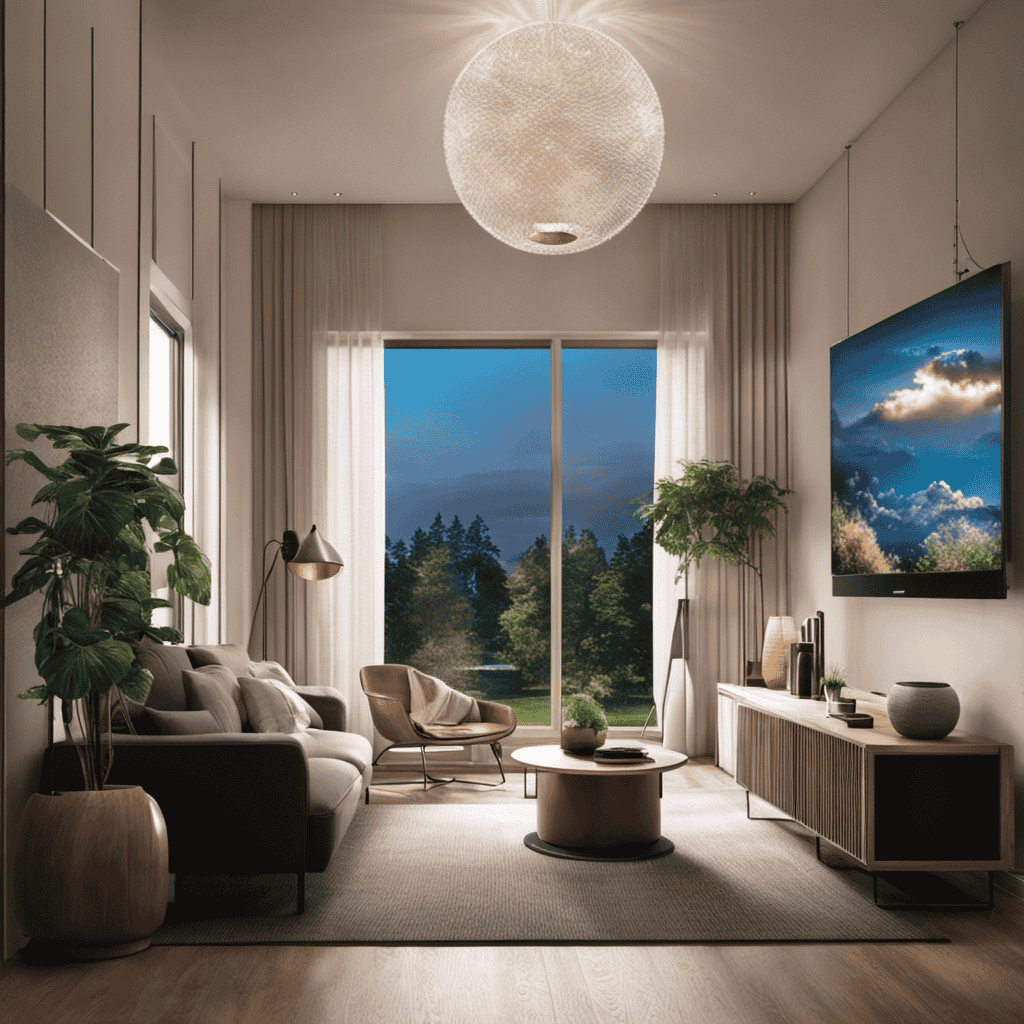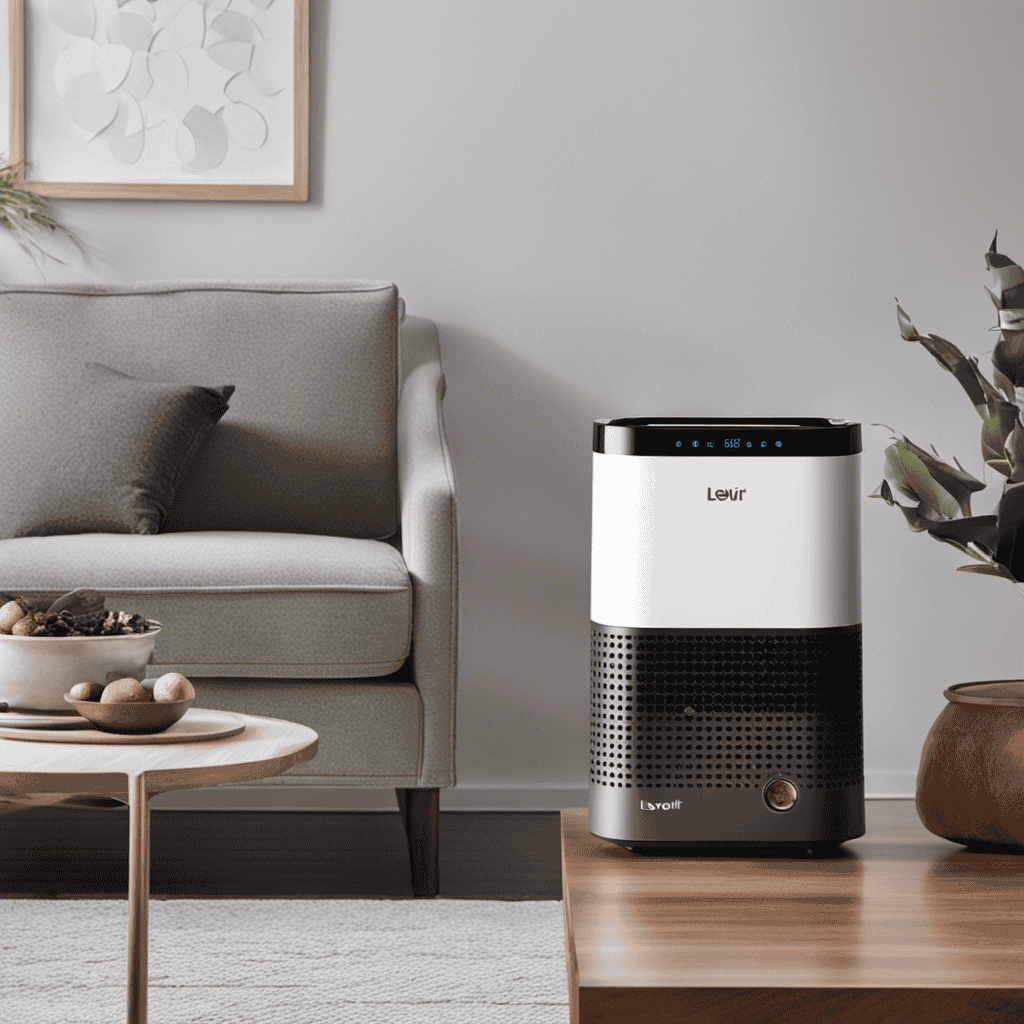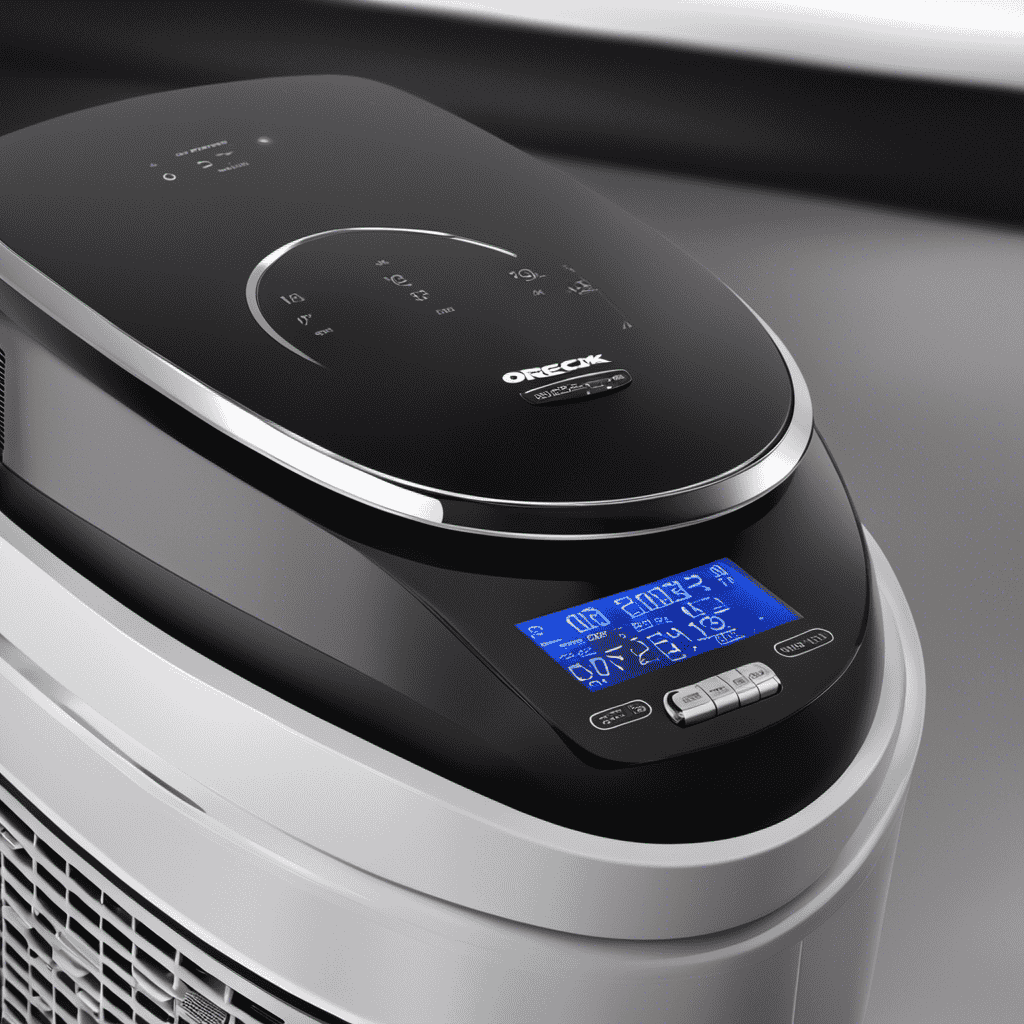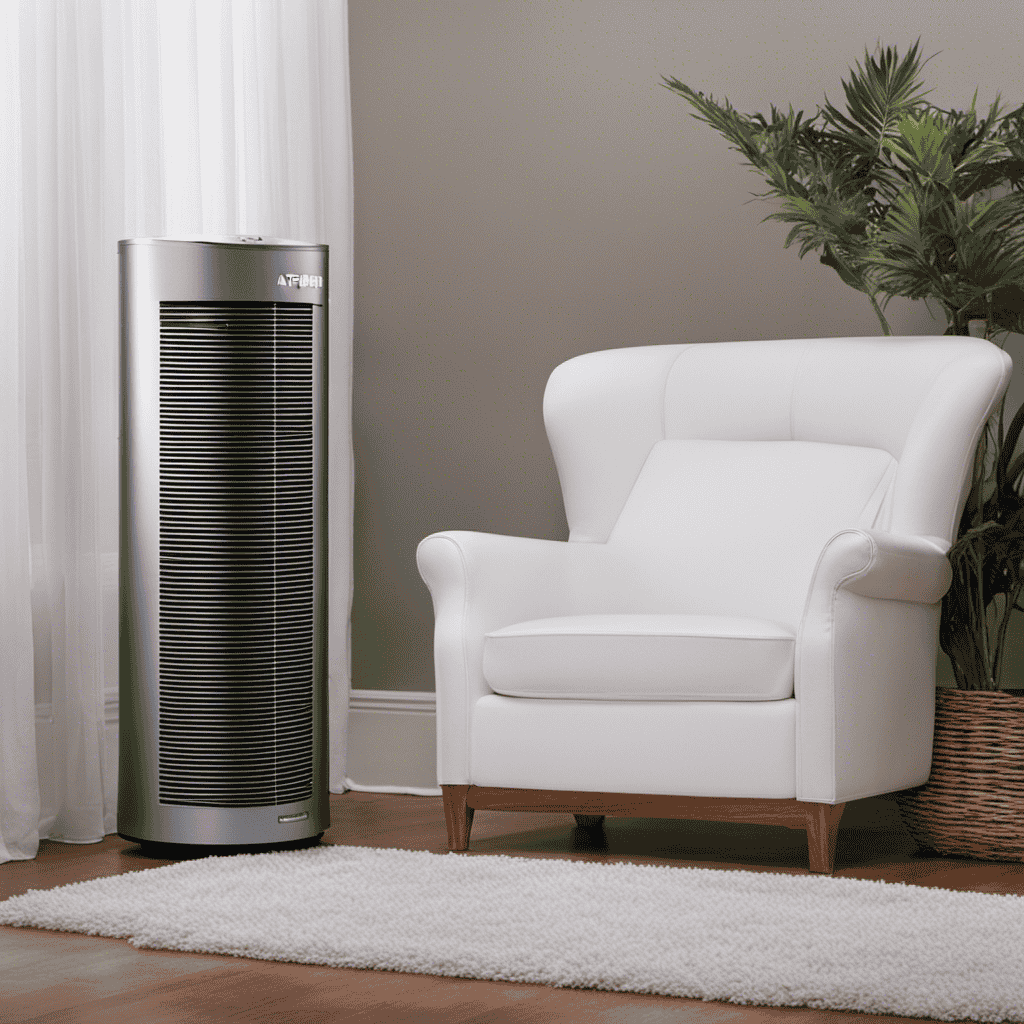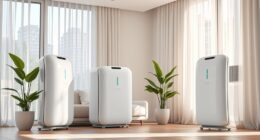You might be wondering: Why should I get an air purifier?
Well, let me tell you, the benefits are undeniable.
Air purifiers not only improve indoor air quality, but they also reduce allergens, remove airborne pollutants, and eliminate odors.
If you suffer from asthma or respiratory issues, air purifiers can greatly improve your symptoms.
They also play a crucial role in controlling pet dander and removing smoke and chemical fumes.
So, if you want cleaner, healthier air in your home, an air purifier is a must-have.
Key Takeaways
- Air purifiers improve overall health and well-being.
- Air purifiers reduce allergy symptoms and alleviate respiratory problems.
- Air purifiers eliminate harmful particles and odors.
- Air purifiers improve air quality and create a healthier and more comfortable living environment.
Health Benefits of Using an Air Purifier
Using an air purifier can greatly improve your overall health and well-being. Air purifiers for allergies are specifically designed to remove allergens and pollutants from the air, providing you with clean and fresh indoor air.
The benefits of clean air are numerous and can have a significant impact on your health. Breathing in clean air can reduce the symptoms of allergies such as sneezing, coughing, and watery eyes. It can also help alleviate respiratory problems like asthma and improve lung function.
Clean air can promote better sleep, boost concentration, and enhance overall productivity. Additionally, air purifiers can eliminate harmful particles and odors, creating a healthier and more pleasant living environment.
With the constant exposure to pollutants in our daily lives, investing in an air purifier is a wise decision to safeguard your health.
Allergen Reduction With Air Purifiers
By reducing allergens, air purifiers can help alleviate symptoms for those with allergies. Air purifiers are effective in reducing indoor pollutants such as pollen, pet dander, dust mites, and mold spores. These microscopic particles can trigger allergic reactions and respiratory issues, making it crucial to have a clean and purified indoor environment. With the use of an air purifier, these allergens are captured and trapped, preventing them from circulating in the air we breathe. This can greatly improve the air quality and provide relief to allergy sufferers.
To better understand the impact of allergen reduction, consider the following table:
| Allergen | Before Air Purifier | After Air Purifier |
|---|---|---|
| Pollen | High | Low |
| Pet Dander | High | Low |
| Dust Mites | High | Low |
| Mold Spores | High | Low |
As you can see, the air purifier effectively reduces the presence of allergens, resulting in a healthier and more comfortable living environment. With improved indoor air quality, allergy symptoms can be minimized, allowing individuals to breathe easier and enjoy a better quality of life.
Transition: Now that we understand the importance of reducing allergens, let’s explore how air purifiers can effectively remove airborne pollutants from our homes.
Removing Airborne Pollutants With an Air Purifier
As someone concerned about my indoor air quality, I’m interested in discussing the health benefits of air purifiers. They have been shown to effectively remove harmful pollutants from the air, such as bacteria, viruses, and mold spores. This leads to a healthier living environment. Air purifiers also have the ability to reduce allergens and dust particles, which can help alleviate symptoms for those with allergies or respiratory conditions. The improvement they can bring to the overall air quality in my home is significant.
Health Benefits of Purifiers
You’ll notice a significant improvement in your overall health when using an air purifier.
Air purifiers are highly effective at removing airborne pollutants, such as dust, pollen, pet dander, and mold spores, from the air you breathe. By eliminating these harmful particles, air purifiers help reduce the risk of allergies, asthma attacks, and respiratory infections.
Regular maintenance of your air purifier is essential to ensure its continued effectiveness. This includes cleaning or replacing filters, checking for any blockages, and ensuring proper airflow. Neglecting maintenance can result in reduced performance and compromised air quality.
Indoor Air Quality Improvement
Improving indoor air quality is essential for maintaining a healthy environment. Air pollution control is a significant concern, as it can lead to various health issues such as respiratory problems, allergies, and even cardiovascular diseases.
This is where air purifiers come in. Air purifiers are devices designed to remove contaminants from the air, improving indoor air quality. They work by filtering out particles like dust, pollen, pet dander, and even harmful gases and odors.
The benefits of using an air purifier go beyond just cleaning the air. They can help reduce the risk of allergies, asthma attacks, and other respiratory conditions. By removing pollutants, air purifiers create a cleaner and healthier environment for everyone.
Transitioning into the subsequent section about allergen and dust reduction, let’s explore how air purifiers can effectively tackle these specific issues.
Allergen and Dust Reduction
To effectively reduce allergens and dust in your indoor environment, it’s important to consider additional methods besides using an air purifier. While air purifiers offer numerous benefits in improving indoor air quality, they may not be the sole solution to combat allergens and dust.
One key factor to consider is dust mite control. Dust mites are tiny creatures that thrive in warm and humid environments, feeding on dead skin cells. To minimize their presence, regular cleaning and vacuuming are crucial. Additionally, washing bedding and curtains in hot water can help eliminate dust mites. Using mattress and pillow encasements can also provide an extra layer of protection.
By incorporating these methods alongside an air purifier, you can greatly enhance the reduction of allergens and dust in your indoor space.
Now, let’s explore how air purifiers further improve indoor air quality.
How Air Purifiers Improve Indoor Air Quality
Air purifiers can significantly enhance the quality of the air in your home. They play a crucial role in reducing allergens and improving sleep quality. By removing airborne particles such as dust, pollen, pet dander, and mold spores, air purifiers create a healthier environment for those suffering from allergies. Additionally, the improved air quality can lead to better sleep as it reduces the chances of breathing in irritants that can disrupt sleep patterns.
To better understand the benefits of air purifiers, let’s take a look at the following table:
| Air Purifier Features | Allergen Reduction | Sleep Quality Improvement |
|---|---|---|
| HEPA Filter | Yes | Yes |
| Activated Carbon Filter | Yes | Yes |
| UV-C Light Technology | Yes | Yes |
As you can see, air purifiers equipped with HEPA filters, activated carbon filters, and UV-C light technology effectively reduce allergens and improve sleep quality. By investing in an air purifier, you can create a healthier and more restful environment in your home.
In the next section, we will explore how air purifiers can eliminate odors through their purification process.
Odor Elimination Through Air Purification
Clean air is essential for maintaining a healthy and comfortable indoor environment. One of the benefits of clean air is the elimination of unpleasant smells that can linger in our homes or workspaces.
Through the use of air purifiers, we can effectively remove odors and improve indoor air quality, ensuring a more pleasant and enjoyable living or working environment.
Benefits of Clean Air
You’ll appreciate the numerous benefits of breathing in fresh, purified air. Clean air is essential for our overall well-being, as it provides a range of health benefits.
One of the main advantages is the reduction of air pollution. Outdoor air pollution, caused by vehicle emissions, industrial activities, and natural factors, can have detrimental effects on our respiratory system and cardiovascular health. By using an air purifier, you can remove harmful particles and pollutants from the air, creating a healthier environment indoors.
Breathing in clean air can also improve sleep quality, boost productivity, and enhance cognitive function. Additionally, it can alleviate symptoms of allergies and asthma, allowing you to breathe more freely.
Now, let’s explore how air purifiers can help in eliminating unpleasant smells.
Eliminating Unpleasant Smells
Eliminating unpleasant smells is one of the key benefits that an air purifier provides. Whether you are a pet owner or working in a busy workplace, odors can be a nuisance and affect your overall comfort and productivity. Air purifiers are designed to effectively remove pet dander, hair, and odor particles from the air, making your home or office space more pleasant and breathable. Not only do they improve air quality, but air purifiers also help reduce allergens and airborne pollutants, creating a healthier environment for everyone. In addition, air purifiers for pet owners often come with specialized filters that target pet-related odors and allergens. Similarly, using air purifiers in the workplace can help eliminate unpleasant odors caused by cooking, cleaning chemicals, or even the presence of mold or mildew. By investing in an air purifier, you can enjoy cleaner and fresher air, promoting a more enjoyable and productive living or working space.
| Benefit | Description |
|---|---|
| Eliminates unpleasant smells | Removes pet odors, cooking smells, cleaning chemical odors, and other unpleasant odors from the air. |
| Reduces allergens and pollutants | Filters out allergens such as pet dander, pollen, dust mites, and airborne pollutants for a healthier space. |
| Promotes a healthier environment | Improves indoor air quality, reducing the risk of respiratory issues and creating a healthier living or working space. |
Improved Indoor Air Quality
Breathing in cleaner air inside your home or office can have a positive impact on your overall health and well-being. An air purifier can help improve indoor air quality by removing harmful pollutants and allergens.
Here are a few key benefits of using an air purifier:
-
Reduced allergens: An air purifier can capture and remove common allergens like pollen, dust mites, pet dander, and mold spores from the air.
-
Odor elimination: Some air purifiers are equipped with activated carbon filters that can effectively trap and eliminate unpleasant odors from cooking, pets, or tobacco smoke.
-
Improved respiratory health: By removing airborne particles and irritants, air purifiers can help reduce respiratory issues such as asthma and allergies.
-
Better sleep quality: Cleaner air can lead to a more restful sleep, as it reduces potential sources of irritation and disturbance.
-
Cost-effective maintenance: Air purifiers typically require minimal maintenance, with most models only requiring filter replacements every 6 to 12 months, making them a cost-effective solution for clean indoor air.
Investing in an air purifier can greatly improve the quality of the air you breathe indoors while providing numerous health benefits.
Air Purifiers for Asthma and Respiratory Issues
If you have asthma or other respiratory issues, using an air purifier can help alleviate symptoms. Air purifiers are designed to filter out airborne particles and pollutants, improving the air quality in your home or office.
For allergies, air purifiers can be particularly beneficial as they can remove allergens such as pollen, dust mites, and pet dander from the air. This can significantly reduce allergy symptoms and provide relief for those who suffer from seasonal allergies or hay fever.
Additionally, air purifiers can also help with pet-related respiratory issues by capturing pet hair, dander, and odors. By removing these irritants from the air, air purifiers can create a healthier and more comfortable environment for individuals with asthma or allergies.
The Role of Air Purifiers in Pet Dander Control
As a pet owner, I understand the struggle of dealing with pet allergies caused by pet dander. That’s why the role of air purifiers in pet dander control is crucial.
Air purifiers are designed to remove airborne particles, including pet dander, from the air, helping to reduce the impact of pet allergies. Here are some key ways air purifiers can help:
- Capture and trap pet dander particles in specialized filters.
- Reduce the amount of pet dander circulating in the air.
- Improve indoor air quality by removing other allergens like dust mites and pollen.
- Minimize allergic reactions, such as sneezing and itchy eyes.
- Create a healthier environment for both you and your pets.
Air Purifiers for Smoke and Chemical Fume Removal
Using an air purifier can effectively remove smoke and chemical fumes from your indoor environment. These pollutants can be harmful to your health and can linger in the air even after the source has been removed.
Air purifiers equipped with activated carbon filters are particularly effective in capturing and neutralizing smoke particles and chemical fumes. These filters contain a porous carbon material that adsorbs the pollutants, trapping them and preventing them from being released back into the air.
Additionally, air purifiers with HEPA filters can also help remove pet hair and mold spores, which can trigger allergies and respiratory issues. These filters are designed to capture tiny particles, including pet dander and mold spores, ensuring cleaner and healthier indoor air quality.
Choosing the Right Air Purifier for Your Needs
When selecting the right air purifier for your needs, consider factors such as room size, filtration technology, and noise level.
Air purifiers come in a variety of brands, each with their own pros and cons. Here are some key considerations to keep in mind:
-
Room size: Ensure that the air purifier is suitable for the size of the room you intend to use it in. Smaller purifiers may not be effective in larger spaces.
-
Filtration technology: Look for purifiers that use HEPA filters, as they are highly efficient at capturing particles as small as 0.3 microns.
-
Noise level: Some purifiers can be quite loud, so consider your tolerance for noise when making your selection.
-
Cost: Compare prices of different air purifier brands to find one that fits your budget.
-
Maintenance: Consider the cost and frequency of filter replacements, as well as any additional maintenance requirements.
Frequently Asked Questions
How Long Do Air Purifiers Typically Last Before Needing to Be Replaced?
Air purifiers typically last for several years before needing replacement. Signs of a failing air purifier include decreased effectiveness in removing pollutants, strange noises, and a noticeable decline in air quality.
Can Air Purifiers Help With Reducing the Spread of Viruses and Bacteria?
Air purifiers can help reduce the spread of viruses and bacteria by trapping and filtering airborne particles. They are particularly beneficial for those with allergies or asthma, improving air quality and reducing symptoms.
Are There Any Potential Side Effects or Risks Associated With Using an Air Purifier?
There are potential health risks associated with using air purifiers. It is important to consider the effectiveness and potential side effects before using one.
Can Air Purifiers Remove Mold Spores and Prevent Mold Growth in a Home?
Air purifiers are effective against mold by removing mold spores from the air. This prevents mold growth in homes. Studies show that air purifiers for allergies can reduce airborne mold spores by up to 90%.
Are There Any Specific Maintenance Requirements for Air Purifiers to Ensure Optimal Performance?
Air purifier maintenance is crucial for optimal performance. Regular filter replacement ensures clean air by removing pollutants. Proper care and cleaning of the unit can extend its lifespan and effectiveness.
Conclusion
In conclusion, I have found that using an air purifier in my home has been incredibly beneficial.
Not only does it help reduce allergens and remove airborne pollutants, but it also improves indoor air quality and eliminates unpleasant odors.
For those with asthma or respiratory issues, an air purifier can provide relief and improve breathing.
Additionally, it is highly effective in controlling pet dander and removing smoke and chemical fumes.
When choosing an air purifier, it is important to consider your specific needs and select the right one for you.
Overall, investing in an air purifier is a wise decision, as it creates a breath of fresh air in your living space.
